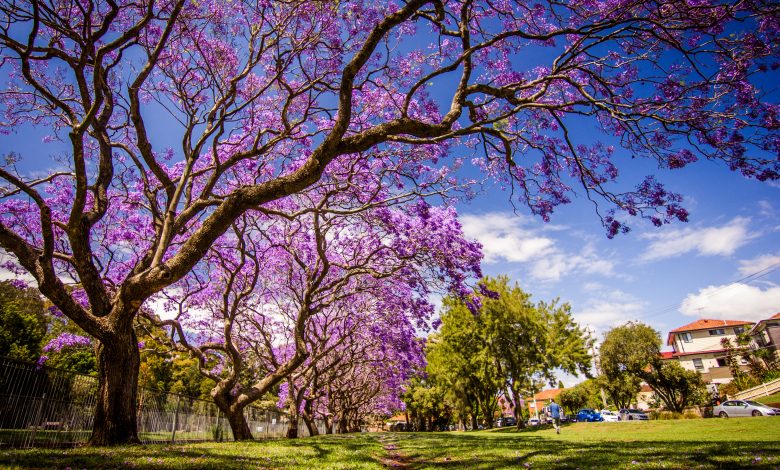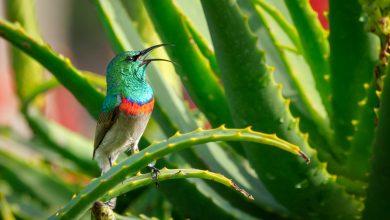7 Stunning Trees with Purple Flowers

There is something about a purple flower that distinguishes it from the beauty of other colorful buds. While reds, pinks, and blue colored flowers can also mesmerize the eye, the vivid splash of color provided by a purple flower can outshine other shades. So to highlight the picturesque purple flower, below is a list of seven purple-flowered trees that you can grow in your garden.
1. Jacaranda
Scientific name: Jacaranda mimosifolia
Also known as the Brazilian rosewood and blue trumpet tree, the Jacaranda is a gorgeous tropical specimen and one of the most admired purple-flowering trees in the world. Jacaranda trees are native to the tropical rainforests of South and Central America. Indigenous Jacaranda trees in Argentina and Bolivia can grow as tall as 50 feet high and 30 feet wide.
Another type of Jacaranda that is indigenous to Brazil and Mexico is called the Jacaranda jasminoides. This tree can grow more reasonably between six to 12 feet tall and four to eight feet wide.
The blooms from a Jacaranda are shaped like a trumpet and are tightly bunched together in sweet-smelling clusters.
In warmer climates, the Jacaranda can bloom at any time. But in most areas, blooming begins in late spring and can carry into early summer. Only mature trees will have flowers.
How to Grow Jacaranda Trees
Not everyone can grow a Jacaranda tree because they only grow well in specific environments. In the United States, Florida, Texas, and California are areas where Jacaranda can thrive, but they are not limited to those three states. The lowest temperatures most Jacaranda trees can handle is 40 degrees Fahrenheit.
- Sun: To maximize your Jacaranda’s size and blooms, provide it with the maximum amount of sun. Smaller trees can still grow in light shade if full sun is not available.
- Water: Don’t be shy about watering your Jacaranda. They require consistent water intake throughout the year and need special attention during dry periods.
- Soil: Jacarandas prefer fertile soil that is well-drained but still moist.

2. Purple Orchid Tree
Scientific name: Bauhinia purpurea
The purple orchid is a fast-growing tree that can mature to as large as 35 feet in both height and width. The blossoms on a purple orchid can grow to five inches wide and feature purple and lavender petals that look like an orchid flower.
Flowers from the purple orchid begin to appear in September and bloom into November. The purple orchid can be perfectly paired with the Jacaranda to keep flowers blooming throughout the changing seasons.
How to Grow Purple Orchid Trees
Purple orchids grow best in zones nine to eleven on the U.S. Department of Agriculture plant hardiness zone scale. These zones encompass most of California, Nevada, Arizona, parts of New Mexico, Texas, and southern states ranging as far north as Tennessee and North Carolina.
If you’re in one of these zones, you can plant a purple orchid tree in nearly any location. Due to a deep root system, you do not need to worry about surface roots popping up.
- Sun: Purple orchids require full sun.
- Water: The purple orchid tree is tolerant of droughts and sometimes flowers more bountifully on dryer soil.
- Soil: Make sure your land has strong drainage characteristics. The pH of your soil should be below the neutral level of 7.5. Soil with a pH above 7.5 will be too alkaline.

3. Crape Myrtle
Scientific name: Lagerstroemia indica
The crape myrtle tree features hundreds of varieties, and the most common of these is the Lagerstroemia indica. Another version you may come across is the Japanese crape myrtle, Lagerstroemia faurei, which can handle cold environments and is resistant to disease. Crape myrtle trees are low-maintenance and can handle a hot and humid summer just as well as a cold winter.
Midsummer is when you’ll enjoy the full flowers of crape myrtles, which can bloom in colors including red, magenta, pink, purple, lavender, and white.
How to Grow Crape Myrtle Trees
You should plant your new tree during the colder months when plants are dormant. Crape myrtles grow best in hardiness zones six to ten, which includes about two-thirds of the country, excluding mainly the north-central states and much of the northeast.
- Sun: Your tree should be in full sun and have at least six hours of light per day.
- Water: Crape myrtles prefer humid climates and can handle drought once they’re established in the ground.
- Soil: The preferred pH level is similar to the purple orchid at neutral 7.5 or slightly acidic. Well-drained soil works best.
4. Purple Robe Locust
Scientific name: Robinia
Featuring clusters of delightfully fragrant flowers, the purple robe locust is a fast-growing tree that is hardy and easy to grow. The long clusters of purple flowers resemble wisteria blooms as they delicately dangle from branches.
The purple robe locust is limited to the month of May for its blooms.
How to Grow Purple Robe Locust Trees
Purple robe locust trees are among the easiest to grow on this list. On the hardiness scale, purple robes prefer zones four to eight. This includes the vast majority of the United States and excludes only the coldest territories.
- Sun: The purple robe will grow best in full sun but will still develop in light shade.
- Water: Purple robes are tolerant of dryer conditions and require watering only during the driest periods.
- Soil: Almost any soil type is suitable. A neutral pH of 7.5 is ideal, but purple robe locusts can still grow in slightly acidic or slightly alkaline soil.

5. Texas Mountain Laurel
Scientific name: Sophora secundiflora
The Texas mountain laurel may technically be considered a shrub, but its intoxicating purple flowers forced their way onto this list. While the flowers are beautiful to look at, their fragrance is even more enjoyable to smell and can be detected from a fair distance away. The Texas mountain laurel also features large, waxy green leaves that wonderfully frame its flowers.
The lower the elevation, the sooner the mountain laurel will bloom. Flowers can bloom from as early as March to as late as midsummer.
How to Grow Texas Mountain Laurel Trees
Texas mountain laurels are slower growing plants but can grow as large as fifteen feet in height and ten feet in width. Unfortunately, Texas mountain laurels can only live as high as zone 7b on the hardiness scale, limiting it to states with warmer climates.
- Sun: Partial shade is acceptable for growing mountain laurels.
- Water: Mountain laurels require a low to average amount of water.
- Soil: The pH of the land should be alkaline (pH over 7.5), and the ground should have quality drainage.
6. Purple Leaf Plum
Scientific name: Prunus cerasifera
The purple leaf plum is a sight to behold in full bloom. Differing from most plants on this list, it’s the leaves of the purple leaf plum that provide most of the color. The deep purple of the leaves contrasts beautifully with soft white flowers that feature deep purple centers.
The purple leaf plum shows off its flowers in early spring.
How to Grow Purple Leaf Plum Trees
Originally from southeastern Europe and western Asia, the purple leaf plum grows most effectively in hardiness zones four through nine. This includes nearly every part of the continental U.S., excluding only parts of the country with the most extreme temperatures.
Purple leaf plums will grow up to 25 feet tall and equally as wide at full maturity. You can expect about 12–24 inches of growth each year.
- Sun: Full sun is required to keep the deep purple color of the leaves. In the shade, the leaves will turn to green.
- Water: You will only need to worry about watering during the deep summer heat.
- Soil: The pH of the soil should be acidic to provide the richest leaves.

7. Purple Lily Magnolia
Scientific name: Magnolia liliflora
The purple lily magnolia is an excellent addition to any garden. It can work exceptionally well in an Asian garden where the azalea and camellia flowers have yet to bloom. A slow-growing specimen, the purple lily magnolia is the smallest tree on this list and will mature to as high as ten feet tall but may not exceed six feet in height. It will grow slightly smaller in width, from four feet to eight feet wide.
Purple lily magnolia trees will bloom throughout the spring, and even when not blooming, they provide year-round interest with an architectural shape.
How to Grow Purple Lily Magnolia Trees
The gorgeous purple lily magnolia can be grown across hardiness zones five through nine, which includes most of the continental United States.
- Sun: Full sun is required for the best blooms.
- Water: You should water a purple leaf magnolia regularly for the first few years. Once the plant is established, it is moderately tolerant of droughts, so make sure to water it during particularly dry periods.
- Soil: Rich, well-drained soil. The pH of the land should be acidic, and between 5.8 to 6.8 pH.



